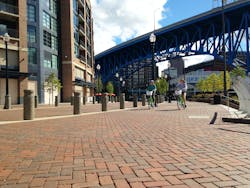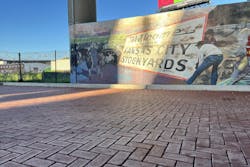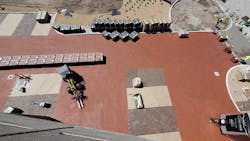Permeable pavement: Aesthetic, durable stormwater management
Permeable pavement isn’t new. Many cities across the U.S. have begun using it for years in projects so they can stay in compliance with U.S. EPA regulations that limit stormwater runoff in combined sewer systems.
The idea behind permeable pavement is that decreasing volumes of stormwater increases capacity for septic sewer, thus eliminating the need to invest in expanding sewage treatment plants while protecting the environment at the same time.
But what is new is an increasing use of segmental pavement, especially clay pavers, for their esthetics, durability and ease of maintenance.
Early adopters
Clay pavers can naturally clean stormwater by filtering it through aggregates into the ground, where it is naturally filtered further.
One of the first commercial uses of the clay pavers was the one site that arguably needed it most: Flats East Bank, adjacent to the Cuyahoga River, in Cleveland, Ohio.
It was the river that famously caught fire in 1969, which accelerated efforts to protect the environment. The result was the Clean Water Act, the Clean Air Act and the founding of the EPA.
There have been improvements to the Cuyahoga. Pollution has been decreased, funding to make improvements has been found, volunteers have been recruited. Dams have been removed to restore habitat for fish and other wildlife.
But one remaining source of pollution is storm drains, which allow sewage, toxins and fertilizer to flow into the river during heavy rains. One solution to that is permeable pavement installations, which absorb the rainwater into the ground.
Elizabeth Hiser, a stream restoration ecologist for Cleveland Metroparks, said that permeable pavements are now used relatively often in Cuyahoga County, especially for development sites with limited space that need to meet post-construction treatment requirements. These permeable pavements provide storage and water quality benefits without losing parking spaces.
“At Cleveland Metroparks, we have focused these applications on parking areas needing retrofit when grant opportunities become available,” said Hiser.
Carla Regener, a natural resources program manager within the Cuyahoga Soil & Water Conservation District, said that a change in regulations allows permeable paving to be used in more places. Ohio now requires 20% of many sites to be reserved for stormwater treatment.
“Sometimes, they will go to permeable pavers because of their aesthetic value,” Regener said. “Schools, apartments, a public square. We have a huge complex down the street, at an office building and grocery store — clay brick and concrete. After Flats East Bank went in, it does seem to be increasing.”
A demonstration project
Farther west, in Kansas City, Missouri, the city’s Water Services Department created a sustainable green infrastructure demonstration project in the city’s Central Industrial District (CID), also known as the Historic West Bottoms.
Down in the floodplains of the Kansas and Missouri Rivers, not far from their confluence, the idea was to minimize urban stormwater runoff from expansive paved areas.
Heading up the project was engineering firm HNTB Corporation. HNTB specified 3.4 acres of clay permeable pavers, which now play a major role in the vehicular area of the project.
“One of our strategies for this green stormwater infrastructure pilot project in the West Bottoms was to leverage multipurpose areas including permeable pavers creating accessible greenspace functioning as parking," said Tom Poer, HNTB vice president and water resources project director.
Poer explained that the city is complying with an EPA consent decree to reduce the impact of sanitary sewer overflows.
“One of the strategies at the CID Green Infrastructure site was a pilot program that looked at many green stormwater infrastructure solutions, including permeable paving,” said Poer. “The permeable pavers have been a resilient solution, effectively collecting and treating stormwater in the rock basin below.”
Part of the challenge is the installation. Derek Schneider, principal of Aqua-Paving Construction, said it was the biggest hand-laid project he had ever done.
“Permeable paving is the fastest growing part of the hardscaping industry and it is pulling clay along with it,” said Schneider.
Costs and benefits
Clay pavers are ordinarily more expensive, both to purchase and to install. But Schneider points out that the benefits of longevity, durability and aesthetics are benefits that can offset the initial costs.
“They will look as good 20 years from now as they do the day you put them in,” said Schneider.
It is important to view a permeable installation as a long-term investment. The benefit of clay pavers is that they last for more than a century, while at the same time, maintenance is easy and cost-effective.
Gaps between the pavers, which are themselves filled with chip stone, can become clogged with soil and other debris, which causes rainwater to pool up on the surface instead of flowing freely underneath the pavers.
To address that, Pine Hall Brick Company partnered with Pave Tech and its Typhoon System to demonstrate how the spaces between permeable pavers can be effectively cleaned through a combination of compressed air and a vacuum. The demonstration was held in 2019 at a site in Lancaster, Pennsylvania where permeable clay pavers had been installed in a parking lot five years earlier.
The Typhoon System uses strong blasts of compressed air that blow the joints clean clear down to the setting bed, effectively removing both the joint stone and the very fine debris that is suspended in the joints. The debris is then vacuumed and fresh stone is swept into place.
That test, and a second, similar test conducted by civil and mineral engineers at the University of Toronto, showed that a clogged permeable paver installation was substantially cleaned. The test pavement sites were again able to drain stormwater at approximately the same rate that they were when first installed.
Both tests point to the need for regular maintenance, along with a way to substantially rehabilitate clogged installations without having to go through costly re-installation.
One project that used a lifecycle analysis model was a street in New Albany, Ohio. The model concluded that, when including the expected cost of maintenance in future years, the use of StormPave permeable clay brick pavers from Pine Hall Brick Company costed less than conventional asphalt and storm drains.
“In the Northeast, they are putting in more clay than concrete,” said Schneider. “We are seeing that in other markets. Concrete is never going to catch up with clay because clay is just classic.”
A residential solution
Residential landscape designers are increasingly turning to permeable clay pavers, sometimes for the same reason.
In Orange County, North Carolina, home of the towns of Chapel Hill and Hillsborough, construction that adds impervious surface or “built upon area” — whether new construction or in some cases, an addition to an existing development — require stormwater management.
The regulations were changed several years ago, to meet state-mandated rules for new development, due to pollution in Falls Lake and Jordan Lake that added high levels of nitrogen and phosphorus.
Because the regulations require treatment on pieces of property as small as 12,000 square feet, that means many residential properties must arrange for stormwater to be treated on-site.
Quality Landscapes NC installed the job. Owner JB Brown said that using StormPave worked well on this job because there were already drainage problems that needed to be addressed.
“StormPave made it easier to get the water away and off the property,” said Brown. “It was much more efficient using StormPave instead of allowing the water to go the length of the driveway and run off the bottom."
About the Author
Walt Steele
Walt Steele is the president and CEO of Pine Hall Brick Company, a clay paver manufacturer in the United States. Steele represents the fourth generation of management in the family-owned company, which was founded in 1922. Based in Winston-Salem, North Carolina, Pine Hall Brick manufactures face, paving and special shape clay brick for the residential and commercial construction industry. It operates plants in North Carolina and Georgia and sells brick products in more than 35 different states.





